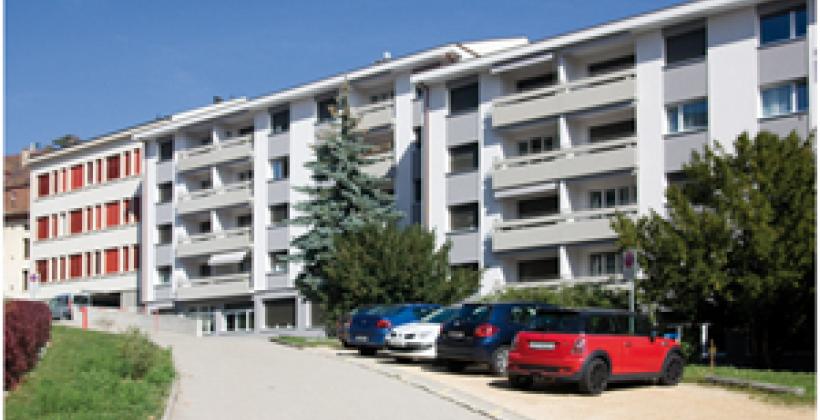
Location
Description
Neuchâtel, a town of 32,000 inhabitants at the Lake Neuchâtel in the western canton of Switzerland, will finalise a series of demonstration projects in 2013. It will be on the path to sustainability through increased renewable energy generation capacity and through the intelligent use of that capacity (new eco-buildings, retrofitting buildings and buildings optimization).
Neuchâtel has established a CONCERTO district, covering 1.5 km² and 4,700 people. Several PV solar plants are being installed, including one built into a new sports stadium with a power of 415 kW. Hydropower and wood boiler are also part of the equation, with the new plant planned for the river Seyon and the wood boiler installed in the retrofit district heating.
Neuchâtel is part of the CONCERTO project HOLISTIC. Picture 1 - Using hydro power at the “Seyon” river Picture 2 – Photovoltaics on the roof of the stadium Picture 3 - The rows of PV panels on the roof of the stadium Picture 4 - Aerial view of the pool Picture 5 - The rebuilt boiler room Figure 1 – Predicted total energy demand of the pool before and after CONCERTO
Documents
Site facts and figures
- Estimated population involved: 4,700
- Approx. geographical area coverage: 150 ha
- Approx. energy saving: 23%
Technologies
Technologymix
At “Rue des Saars” a residential building with 9 dwellings (771 m²) and at “Gibraltar Street 7,9,11” dwelling blocks (3,942 m²) have been retrofitted. The implemented measures comprise insulation (outside wall and roof), replacement of windows (partly by triple pane windows) and installation of solar thermal collectors for domestic hot water preparation. With the university at “Avenue du 1er-Mars 26“ a historical public building has been refurbished. All windows have been replaced, the roof, the outside walls and the basement were insulated, the old electric lighting has been replaced, controlled ventilation and heat exchangers have been implemented and thermostatic valves were installed. The retrofit of the public swimming pool is described in the “more detailed” section.
At the „Ecoparc“ area two new buildings with 40 dwellings have been built. The „CampusArc1“ building, which is used by two higher education institutions, respects “Minergie” standards and more than 70% of its energy consumption is covered by a wood boiler (exclusively local wood). Particular attention was paid to grey energy in materials used for building, a life-cycle analysis was conducted for a number of elements. The “CampusArc2” building („TransEurope“) was designed according to the “Minergie” standard as well, reduction of the heating energy demand was achieved by a well-insulated facade made of prefabricated wood and metal elements and triple-pane windows. Heating and cooling energy is provided by geothermal probes (30 m deep), cooling energy demand is reduced by natural ventilation in summer, possible through the position of skylights.
At „Falaises Street“ five new residential buildings (40 dwellings, 5,331 m²) have been built and an office building (1,570 m²) has been retrofitted. The new residential building is supplied by a compression heat pump, which extracts energy from the water of the nearby lake and will cover 80% of the energy demand.
At the “Maladière” neighbourhood the new tertiary building „Microcity“ (a microtechnology institution, 15,110 m²) is being constructed. Thanks to geothermal probes (for cooling and heating), solar panels and an intelligent choice of building materials, “Microcity” will use considerably less energy than other modern buildings of the same type.
In the field of hydropower two systems have been installed: a new water turbine at the Seyon river (Picture 1) and installation of a turbine at the outlet of a sewage plant. With an installed capacity of 185 kWel the production of hydraulic energy will be around 720 MWh/year. Within the CONCERTO activities also two district-heating networks will be linked and a new wood heating supply (2 MWth power) is installed in order to increase the part of renewable energy production.
A production of 8,000 MWh during 2012 is predicted. The installation of a large PV plant (421 kWpeak) on the “Maladière” stadium (Picture 2) is described in the “more detailed” section.
Photovoltaic Plant
The CONCERTO project encompasses several PV plants inside the network of Viteos, the energy distributor within the HOLISTIC consortium. Among the installations there is the PV plant on the Maladière stadium, which will be completed in three phases. The first 750 m² of PV panels (Picture 3) have already been installed and produce 65 MWh per year. At the end of the project (2012), a total surface of 3,835 m² (421 kWpeak) will have been installed and will produce 414 MWh/a.
Reftrofit of swimming pool “Nid-du-Crô”
The swimming pool (Picture 4) is one of the biggest energy consumers in the city. The planned measures will allow a reduction of the heating energy demand by 62% (2,229 MWh/a) and the electrical energy demand by 10% (126 MWh/a).
The gas boilers are replaced by a heat pump and new condensing boilers (Picture 5), ground water is used in summer for cooling and heat exchangers are installed in the ventilation circuit. Unglazed solar collectors are installed for pool heating and glazed collectors are installed to produce hot water for the showers. Figure 1 shows the total predicted energy demand before and after the CONCERTO activities.
The CONCERTO approach
Overall, Neuchâtel is taking an integrated approach: energy production and consumption measures that will reduce by 23% the use of non-renewable energy, while substantially increasing renewable energy use.
Thematic Field
- New Building(s)
- Refurbished Building(s)
